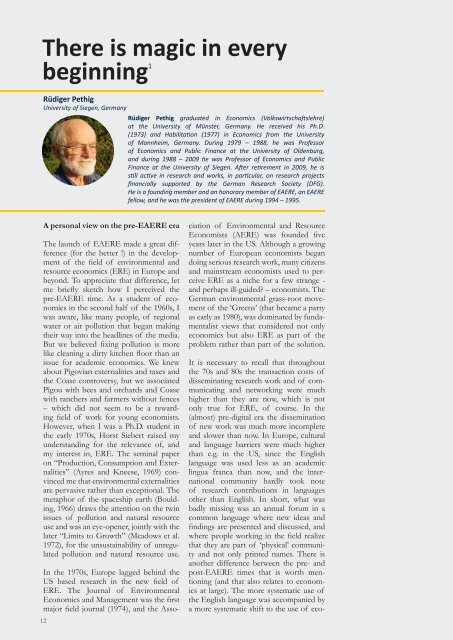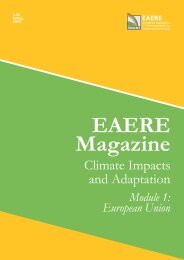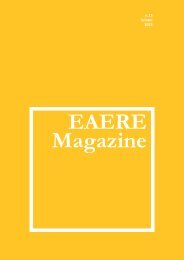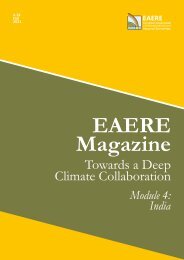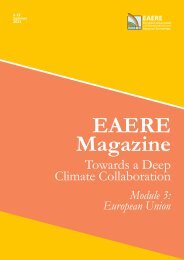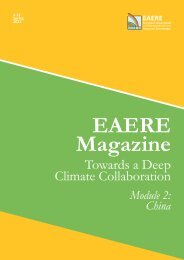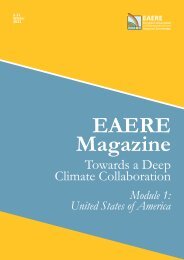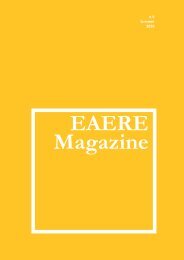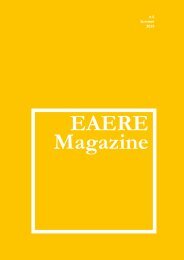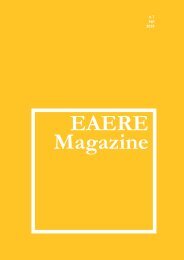EAERE Magazine - n.8 Winter 2020
You also want an ePaper? Increase the reach of your titles
YUMPU automatically turns print PDFs into web optimized ePapers that Google loves.
There is magic in every<br />
beginning 1<br />
Rüdiger Pethig<br />
University of Siegen, Germany<br />
Rüdiger Pethig graduated in Economics (Volkswirtschaftslehre)<br />
at the University of Münster, Germany. He received his Ph.D.<br />
(1973) and Habilitation (1977) in Economics from the University<br />
of Mannheim, Germany. During 1979 – 1988, he was Professor<br />
of Economics and Public Finance at the University of Oldenburg,<br />
and during 1988 – 2009 he was Professor of Economics and Public<br />
Finance at the University of Siegen. After retirement in 2009, he is<br />
still active in research and works, in particular, on research projects<br />
financially supported by the German Research Society (DFG).<br />
He is a founding member and an honorary member of <strong>EAERE</strong>, an <strong>EAERE</strong><br />
fellow, and he was the president of <strong>EAERE</strong> during 1994 – 1995.<br />
A personal view on the pre-<strong>EAERE</strong> era<br />
The launch of <strong>EAERE</strong> made a great difference<br />
(for the better !) in the development<br />
of the field of environmental and<br />
resource economics (ERE) in Europe and<br />
beyond. To appreciate that difference, let<br />
me briefly sketch how I perceived the<br />
pre-<strong>EAERE</strong> time. As a student of economics<br />
in the second half of the 1960s, I<br />
was aware, like many people, of regional<br />
water or air pollution that began making<br />
their way into the headlines of the media.<br />
But we believed fixing pollution is more<br />
like cleaning a dirty kitchen floor than an<br />
issue for academic economics. We knew<br />
about Pigovian externalities and taxes and<br />
the Coase controversy, but we associated<br />
Pigou with bees and orchards and Coase<br />
with ranchers and farmers without fences<br />
– which did not seem to be a rewarding<br />
field of work for young economists.<br />
However, when I was a Ph.D. student in<br />
the early 1970s, Horst Siebert raised my<br />
understanding for the relevance of, and<br />
my interest in, ERE. The seminal paper<br />
on “Production, Consumption and Externalities”<br />
(Ayres and Kneese, 1969) convinced<br />
me that environmental externalities<br />
are pervasive rather than exceptional. The<br />
metaphor of the spaceship earth (Boulding,<br />
1966) draws the attention on the twin<br />
issues of pollution and natural resource<br />
use and was an eye-opener, jointly with the<br />
later “Limits to Growth” (Meadows et al.<br />
1972), for the unsustainability of unregulated<br />
pollution and natural resource use.<br />
12<br />
In the 1970s, Europe lagged behind the<br />
US based research in the new field of<br />
ERE. The Journal of Environmental<br />
Economics and Management was the first<br />
major field journal (1974), and the Association<br />
of Environmental and Resource<br />
Economists (AERE) was founded five<br />
years later in the US. Although a growing<br />
number of European economists began<br />
doing serious research work, many citizens<br />
and mainstream economists used to perceive<br />
ERE as a niche for a few strange -<br />
and perhaps ill-guided? – economists. The<br />
German environmental grass-root movement<br />
of the ‘Greens’ (that became a party<br />
as early as 1980), was dominated by fundamentalist<br />
views that considered not only<br />
economics but also ERE as part of the<br />
problem rather than part of the solution.<br />
It is necessary to recall that throughout<br />
the 70s and 80s the transaction costs of<br />
disseminating research work and of communicating<br />
and networking were much<br />
higher than they are now, which is not<br />
only true for ERE, of course. In the<br />
(almost) pre-digital era the dissemination<br />
of new work was much more incomplete<br />
and slower than now. In Europe, cultural<br />
and language barriers were much higher<br />
than e.g. in the US, since the English<br />
language was used less as an academic<br />
lingua franca than now, and the international<br />
community hardly took note<br />
of research contributions in languages<br />
other than English. In short, what was<br />
badly missing was an annual forum in a<br />
common language where new ideas and<br />
findings are presented and discussed, and<br />
where people working in the field realize<br />
that they are part of ‘physical’ community<br />
and not only printed names. There is<br />
another difference between the pre- and<br />
post-<strong>EAERE</strong> times that is worth mentioning<br />
(and that also relates to economics<br />
at large). The more systematic use of<br />
the English language was accompanied by<br />
a more systematic shift to the use of eco-<br />
12


